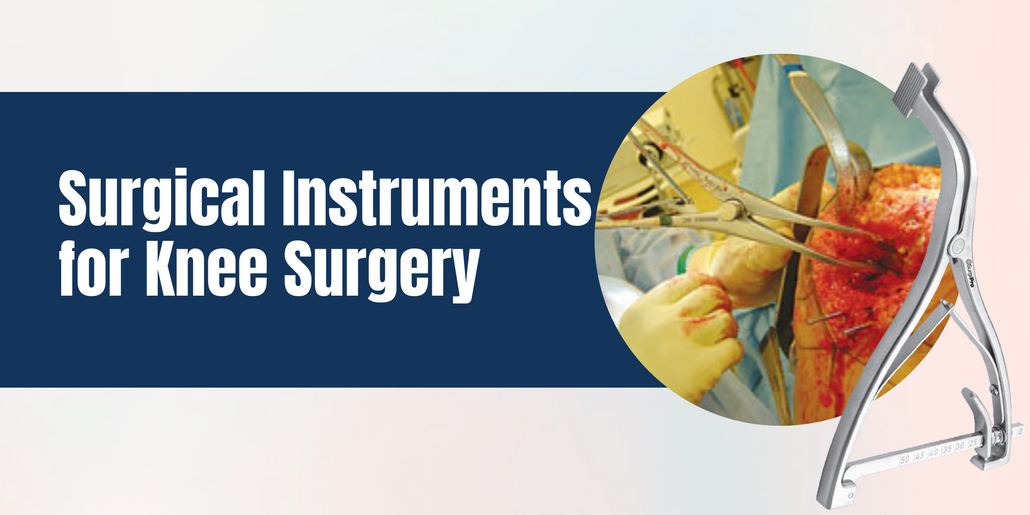
Surgical Instruments for Knee Surgery
Posted on 5th Apr 2022
What is a knee replacement surgery?
The purpose of knee replacement surgery is to resurface damaged areas of the knee joint and to reduce knee discomfort that is uncontrollable with conventional treatments using German surgical instruments. Knee replacement, commonly known as complete knee replacement or knee arthroplasty, is a surgical operation that resurfaces a knee that has been destroyed by arthritis. The extremities of the bones that make up the knee joint, as well as the kneecap, are capped with metal and plastic pieces. If you have severe arthritis or a major knee injury, you may want to consider this operation.
Knee surgery instruments:
- Calibrated Femoral Tibial Spreaders: Designed to help separate the femur and tibia during total knee replacement surgery. It is possible to get a large, uninterrupted view of the posterior compartment, especially if osteoporotic; to avoid breaking the bone without the help of an assistance, the spreader will stay in place with the femur and tibia apart.
- Lombardi Femoral Tibial Spreaders: Thin pads these spreaders help to separate the femur and tibia during total knee procedures.
- Lombardi Gap Balancing Femoral Tibial Spreaders: Designed to aid in the separation of the femur and tibia during total knee replacement procedures, the pads are parallel when measured at 20mm of separation.
- Ortho Self-Retaining Retractors: The calibrated design can aid to balance ligaments during knee replacement procedures by separating the femur and tibia.
- Gelpi Retractors: Gelpi Retractor with Speedlock is used to hold back organs and tissues during knee and spinal surgeries.
- Deep Meyerding Retractor: Designed to help retract a broader area of soft tissue or muscle during knee surgery.
- Knee Spreader: The Knee Spreader is intended to improve perineal stability while also reducing sweat. It has Plastazote padding for added comfort and adjusts to match the correct thigh circumference. Knee and hip positioning is also provided by the knee spreader.
Anatomy of the knee
The quadriceps muscles (located on the front of the thighs), which straighten the legs, and the hamstring muscles (placed on the back of the thighs), which bend the leg at the knee, are two groups of muscles involved in the knee. Tendons are tough connective tissue strands that run between muscles and bones. Ligaments are elastomeric tissue bands that link bones. Some ligaments in the knee provide joint stability and protection, while others limit the tibia’s forward and backward movement (shin bone). The places where two or more bones touch are known as joints. The bones can move since most joints are movable. The knee is made up of two long leg bones that are held together by muscles, ligaments, and tendons. A layer of cartilage covers each bone end, absorbing shock and protecting the knee. The knee is made up of the following parts:
- Femur: This is the thighbone, often known as the upper leg bone.
- Tibia: The shin bone, or bigger bone of the lower leg.
- Patella: This is where the kneecap is located.
- Synovial: A tissue that lines the joint and forms a capsule around it. To lubricate the joint, the synovial membrane secretes synovial fluid (a transparent, sticky fluid).
- Ligament: A tough, elastic connective tissue that surrounds the joint and provides support while also limiting movement.
- Cartilage: At a joint, a sort of tissue that covers the surface of a bone. Cartilage aids in the reduction of friction during joint movement.
- Tendon: Tough connective tissue that connects muscles to bones and assists in joint movement control.
- Meniscus In the knees and other joints, a curved piece of cartilage that acts as a shock absorber, improves contact area, and deepens the knee joint.
Surgery procedure:
Knee replacement surgery is usually done under general anaesthetic while you are unconscious. This will be discussed with you in advance by your anesthesiologist. In general, knee replacement surgery goes like this:
- In your arm or hand, an intravenous (IV) line may be started.
- On the operating table, you will be placed.
- It is possible to install a urinary catheter.
- Hair near the surgery site that is profuse may be trimmed off.
- The doctor will make an incision in the knee area.
- Femur and tibia during total knee replacement surgery will be separate with help of Femoral Tibial Spreaders.
- The doctor will resurface the knee joint with the prosthesis after removing the damaged surfaces. Metal and plastic make up the knee prosthetic. A cemented prosthesis is the most frequent type of artificial knee prosthesis. Surgical cement is used to secure a cemented prosthesis to the bone.
- Stitches or surgical staples will be used to close the incision.
- To remove fluid from the incision site, a drain may be implanted.
- A sterile dressing or bandage will be applied.
